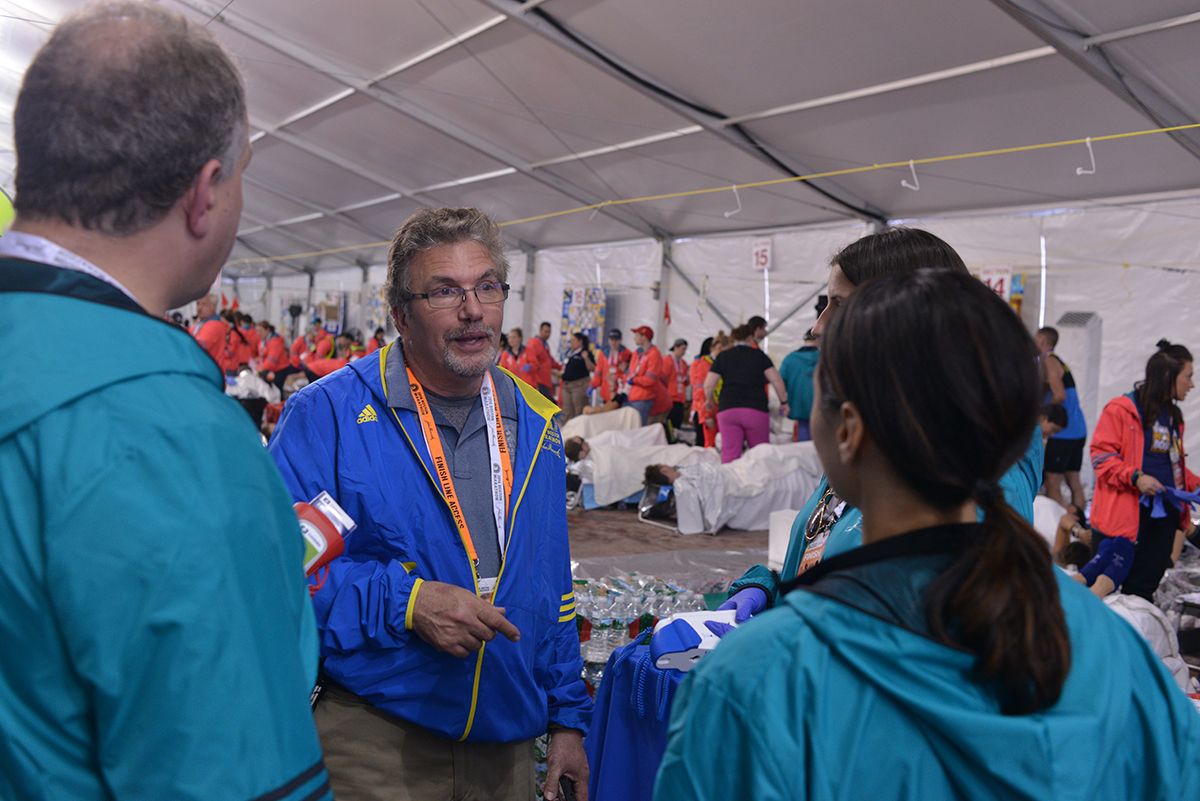What It’s Like Inside the Boston Marathon Medical Tent

Chris Troyanos in the medical tent/Photo by Mickey Goldin
In his 40 years with the Boston Marathon, Chris Troyanos has seen it all.
“We’ve seen just about everything imaginable—and a few things you wouldn’t want to imagine,” Troyanos laughs.
Troyanos first volunteered at the finish line as a third-year Northeastern student. Four decades later, he’s the Boston Marathon’s medical coordinator, overseeing the 28 medical tents and 1,700 medical volunteers who keep the field of thousands safe and healthy. It’s a massive effort, and one Troyanos says he could never do alone.
“We really stress the fact that this is a team, and no one general volunteer or higher echelon leader is above anyone else,” he says. “It’s a huge team effort, and I’m lucky enough to be one of the guys that helps lead it.”
So what’s it actually like in the medical tent on Marathon Monday? We had to find out.
On runners’ most common ailments:
Orthopedic problems are frequent, but Troyanos says dehydration is hands-down the most common issue. “Getting our runners to understand what the correct fluid prescription is for them, how much to drink before, during, and after the race, is a very difficult balance,” he says.
On runners’ most serious ailments:
Some runners experience exertional heat stroke, causing dangerously high core body temperature. Troyanos remembers a few athletes coming into the tent with body temperatures of 109 or 110 degrees—giving the team just 30 minutes to get them back to normal thermic range before risking organ and brain damage. To do so, volunteers must quickly place an IV, check blood sodium levels with a portable device called an i-STAT, and submerge the patient in an ice bath.
It doesn’t stop there. Troyanos says he’s seen runners who have over-hydrated, runners in cardiac arrest, and even a runner with a shattered femur. “I’ll take a sprained ankle any day,” he quips.
The medical tents, by the numbers:
The crew stocks…
- 35,000 gallons of water
- 4,000 bandages
- 900 IV bags
- 45,200 foil blankets
- 28,200 bananas
- 20 i-STAT portable blood monitors
- 25 EKG machines
- 1,490 portable toilets
Figures provided by race sponsor Abbott
On ideal weather:
“I’d love to see it 55 degrees, low humidity, a little bit of sun, and a light north or northwesterly wind,” Troyanos says. “But I don’t always get what I want.”
The worst weather? A hot day, like Marathon Monday 2012, when temperatures crept well into the 80s. Troyanos says his team treated more than 10 percent of the 27,000-person field that year.
On adjusting after the 2013 race:
After the finish line explosions in 2013, medical volunteers leapt into the fray without hesitation. Troyanos calls them “heroes,” but says the incident made him more focused on protecting his team.
“I think we needed to make our volunteers a little bit more aware of just taking a deep breath and making sure that you’re going to be okay if you jump into a scene like that ever again,” he says.
On how the race has changed:
“When I first started, the field size was maybe 2,000 or 3,000 runners,” he remembers. “It takes longer for people to finish [now]. It used to be, people would finish in four, five hours. Now it’s six, seven hours.”
On how to stay out of the tent:
“Runners need to understand what their limitations are, and not try to push them,” Troyanos cautions. “Boston has a tendency for people to want to do their best. We get that. But if you’re aware of your body’s limitations and how you’re feeling and don’t push that, the likelihood is you’re not going to see us in the medical tent.”


